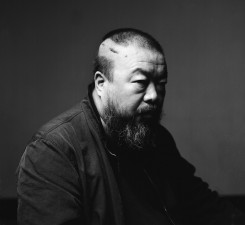At the Art Gallery of Ontario’s (AGO) latest exhibit, Ai Weiwei: According to What?, the living artist engages visitors in political conversations through aesthetic means.
While circling the heaviest installation at the exhibit, “Straight” (it weighs around 38 metric tons), I was compelled not only to admire the beauty of the waves in material, but also to ask a few questions. What are these long pieces of metal? Where did they come from? Ai collected these pieces of rebar from the collapsed schools where 5,196 schoolchildren died after the 2008 Sichuan earthquakes.
 On the wall facing “Straight,” is another artwork, “Names of the Student Earthquake Victims Found by the Citizens” Investigation’, which has been recreated from the original list of names printed on the walls of Ai’s studio in China. These two works, and the accompanying wall texts provided by the AGO, lead to a greater question: could the death of these children have been avoided? Ai asks this question, and many more.
On the wall facing “Straight,” is another artwork, “Names of the Student Earthquake Victims Found by the Citizens” Investigation’, which has been recreated from the original list of names printed on the walls of Ai’s studio in China. These two works, and the accompanying wall texts provided by the AGO, lead to a greater question: could the death of these children have been avoided? Ai asks this question, and many more.
U of T Department of Art professor, Mark Cheetham, was concerned that the exhibit would not live up to the expectations created by the extensive publicity it received prior to the opening. After viewing the exhibit himself, he was relieved to see Ai’s work “beautifully installed.” When asked what he thought of the exhibit, he responded, “I was moved by the interconnectedness of Mr. Ai’s pieces, their sense of quiet reflection and social engagement, sometimes mixed with playfulness.” It was in Cheetham’s Art Since 1900 class that I received my first introduction to Ai’s work. While viewing Ai’s “Château Lafite,” a sculptural piece featured in the exhibit, I recall other artists such as Marcel Duchamp and his ready-made works. Behind a glass is a bottle of Château Lafite with two shoes strapped to either side. This artwork shows the lighter, more playful side to Ai and the influence of post-modern artists before him, as does another work, the “Coca-Cola Vase.” In what seems to be homage to Andy Warhol, an ancient artifact is painted with the Coca-cola logo, creating the perfect mix of old with new. This fun work, among others, is sure to satisfy the cravings of pop-art lovers and post-modern enthusiasts.
“It’s not often you get to talk about art and the state of the world at the same time,” says AGO director and CEO Matthew Teitelbaum. The exhibit at the AGO is a rare opportunity for visitors to engage socially with art while reflecting upon their own world.
According to what? is on now until October 27 at the AGO. For more by Ai Weiwei, check out his largest ever Forever Bicycles installation at Nathan Phillips Square as part of Scotiabank Nuit Blanche on October 5.


